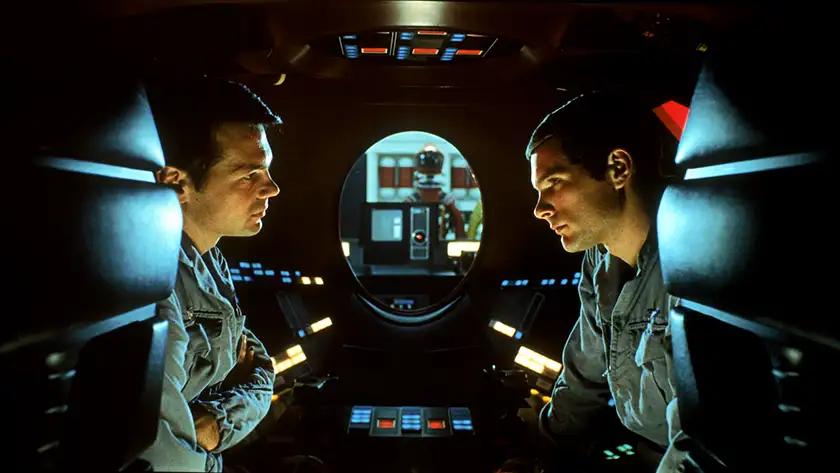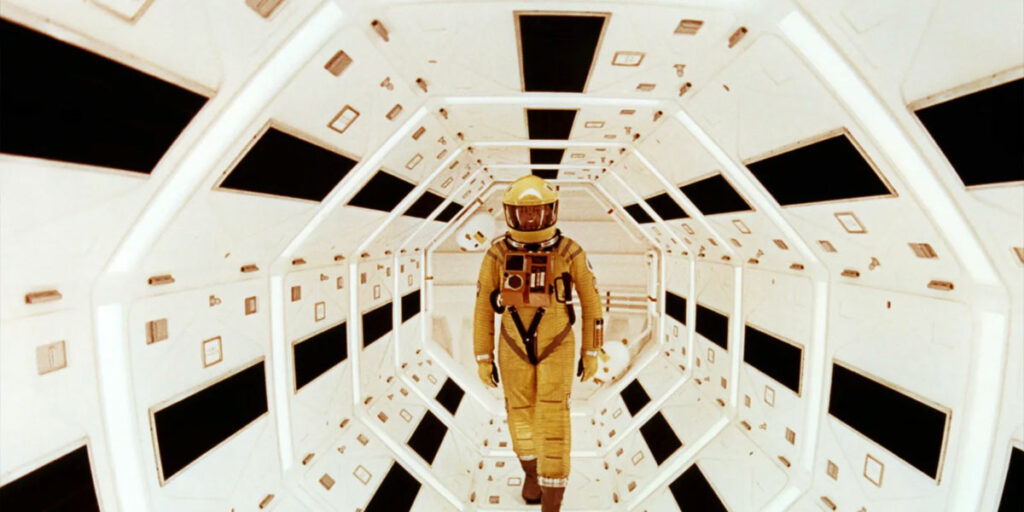Stanley Kubrick delivers a masterclass in filmmaking in 2001: A Space Odyssey, one of the most ambiguous and debated films of all time.
Produced, co-written (with author Arthur C. Clarke) and directed by Stanley Kubrick, 2001: A Space Odyssey is an epic science fiction film. Not only did it change the way we think of science fiction as a genre, but it is one of the rare films that can truly stand the test of time. Considering that the movie was made in 1968, its use of special effects and unconventional editing techniques is all the more impressive. Watching it in 2024, its depiction of artificial intelligence also particularly stands out, as it is still very timely and accurate to our current worries around it.
2001: A Space Odyssey starts with a tribute of prehistoric apes who are driven away from their territory by a rival tribe. Once an alien monolith appears in front of them, the apes learn how to use a bone as a weapon, successfully driving their enemies away. Then, the film cuts to millions of years later, with one of the most memorable shots in film history: as one of the apes lifts a bone up in the air, symbolising its first use as a weapon, the film cuts to a similarly shaped spaceship thousands of year into the future. Although it may be explicit, this match cut suggests that the latter is the ultimate weapon of men, illustrating the progress of humanity in all these years.
From then on, 2001: A Space Odyssey is set in the future, on an American lunar outpost called Clavious Base, where Dr Heywood Floyd (Roy Scheider) discusses their newest discovery, and the need for secrecy around it. A few months later, the movie follows a voyage to Jupiter to investigate an alien monolith, which keeps inexplicably coming back in various parts of the film, connecting past and future. On the ship are astronauts and scientists, including Dr David Bowman (Keir Dullea), and HAL (Douglas Rain), a sentient artificial intelligence. Eventually, HAL starts showing signs of distress, exhibiting increasingly strange behaviour, which leads to a tense confrontation between man and machine.
As a science fiction film made in 1968, one of the biggest challenges of 2001: A Space Odyssey lay in depicting the future in which it is set. Its portrayal of a then-futuristic 2001 was spectacular at the time, thanks to its imaginative suppose of special effects, but it is even more impressive now. Today, we can see how it still holds up, no matter how many years have passed or how much VFX technology has evolved since then. When imagining the future, the movie strived for realism: although not everything we see in the film necessarily came true, most of it is plausible enough and some of it did come true.

When watching 2001: A Space Odyssey in 2024, its relevance to today is quite surprising, especially as it still speaks to the same anxieties and concerns we have around the use of artificial intelligence. Interestingly, HAL sometimes seems to be acting as the most human character in the film: he appears to have developed a human level of intelligence, with emotions – such as paranoia and guilt – that are normally associated with humanity. On the contrary, the human characters seem to be acting like machines themselves, as they are solely focused on the tasks at hand.
One of the most impressive elements of 2001: A Space Odyssey is its use of music and sound. While there isn’t much dialogue in the film, the plot moves forward thanks to the music and the editing rather than the lines themselves. The iconic match cut, one of the most famous sequences in film history and filmmaking, is just an example of how Kubrick is able to convey complex ideas through one single cut. In a short sequence, the film’s juxtaposition of two entirely different objects and timelines illustrates the technological progress since the Dawn of Men.
The Monolith is key to this progress. The audience sees it four times during the movie, at first with the apes as they learn how to fight their enemies and in the final sequence of the movie. At the end of the film, Dave finds himself in a large neoclassical room where he becomes an older version of himself just before the monolith appears before him. While there are many interpretations for this, I think the Monolith can be seen as a God-like figure from the way the apes, and astronauts afterwards, react to it in 2001: A Space Odyssey. If the monolith is, in fact, a representation of a Godly figure, then the end of the film – the last time we see it – may represent its death.
The overall meaning of 2001: A Space Odyssey has been purposefully left ambiguous and up to the audience, but the music might offer us a key to interpret it. In its soundtrack, A Space Odyssey famously features various classical pieces, including Strauss’s “Also Sprach Zarathustra.” While classical music is often associated with calm and relaxing tones, the music in Strauss’s piece creates a sinister and triumphant atmosphere at the same time thanks to its use of the C major key to symbolise the mysterious of the world and upcoming evolution.
The use of “Also Sprach Zarathustra” also points to Nietzsche’s philosophical novel of the same name. Nietzsche writes about the man – represented by the astronauts in the film – as a bridge between the apes – present in the first section of the movie – and the Ubermensch, which we can see at the end of the film. In this sense, the end of the film could represent the death of God, which illustrates the loss of universal values and moral truths. As Dave reaches for the Monolith, in a shot that visually reminds us of Michelangelo’s “Creation of Adam,” he is suddenly transformed into a foetus floating in a space above Earth which could, subsequently, represent the Übermensch, the realization of man’s full potentiality and creativity, and, therefore, the potential birth of a new set of values and ideas.
In the end, whatever interpretation we attribute to the Monolith, or the movie as a whole, is perhaps not the point of 2001: A Space Odyssey. Instead, the most impressive achievement of all seems to be the fact that it made its audience think and debate the ultimate meaning behind the film for all these years. This sparked an extensive discussion around the film, unlike anything else before or after it in terms of the cultural phenomenon it created, thus helping it become the immortal masterpiece that Kubrick’s film is considered to be today.
2001: A Space Odyssey is now available to watch on digital and on demand. Read all our Stanley Kubrick reviews!
Loud and Clear Reviews has an affiliate partnership with Apple, so we receive a share of the revenue from your purchase or streaming of the films when you click on the button on this page. This won’t affect how much you pay for them and helps us keep the site free for everyone.

